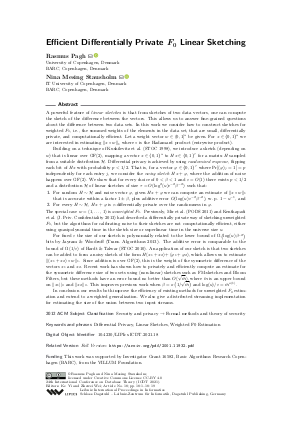@InProceedings{pagh_et_al:LIPIcs.ICDT.2021.18,
author = {Pagh, Rasmus and Stausholm, Nina Mesing},
title = {{Efficient Differentially Private F₀ Linear Sketching}},
booktitle = {24th International Conference on Database Theory (ICDT 2021)},
pages = {18:1--18:19},
series = {Leibniz International Proceedings in Informatics (LIPIcs)},
ISBN = {978-3-95977-179-5},
ISSN = {1868-8969},
year = {2021},
volume = {186},
editor = {Yi, Ke and Wei, Zhewei},
publisher = {Schloss Dagstuhl -- Leibniz-Zentrum f{\"u}r Informatik},
address = {Dagstuhl, Germany},
URL = {https://drops.dagstuhl.de/entities/document/10.4230/LIPIcs.ICDT.2021.18},
URN = {urn:nbn:de:0030-drops-137264},
doi = {10.4230/LIPIcs.ICDT.2021.18},
annote = {Keywords: Differential Privacy, Linear Sketches, Weighted F0 Estimation}
}

 Creative Commons Attribution 4.0 International license
Creative Commons Attribution 4.0 International license





















